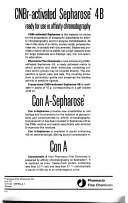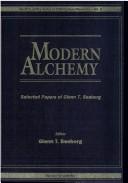| Listing 1 - 10 of 67 | << page >> |
Sort by
|
Multi
ISBN: 9780128136447 0128136448 9780128136430 012813643X Year: 2018 Publisher: Amsterdam, Netherlands : Elsevier,
Abstract | Keywords | Export | Availability | Bookmark
 Loading...
Loading...Choose an application
- Reference Manager
- EndNote
- RefWorks (Direct export to RefWorks)
Nuclear and Radiochemistry, Second Edition, is a comprehensive and thorough reference that features the latest developments in the field, especially in radionuclide production, nuclear medicine and the application of natural radiotracers. Drawing on 40 years of experience in teaching and research, this revised edition explains the basic principles and applications of the primary areas of nuclear and radiochemistry. This new edition features completely revised chapters, in addition to 40 new illustrations plus case studies woven throughout the text. It will be helpful to students and researchers in chemistry, chemical engineering, environmental sciences and specialists working in all fields of radiochemistry. The field of nuclear and radiochemistry is wide-reaching, with results having functions and use across a variety of disciplines. Separate chapters cover each main area of recent radiochemistry. This includes nuclear medicine and chemical aspects of nuclear power plants, namely the problems of nuclear wastes and nuclear analysis (both bulk and surface analysis), with the analytical methods based on the interactions of radiation with matter. Furthermore, special attention is paid to thermodynamics of radio-isotope tracer methods, the very diluted system (carrier-free radioactive isotopes) and the principles of chemical processes with unsealed radioactive sources.
Periodical
ISSN: 16083288 10663622 Year: 1993 Publisher: New York : [New York] : Consultants Bureau, Kluwer Academic-Plenum-Human Sciences Press
Abstract | Keywords | Export | Availability | Bookmark
 Loading...
Loading...Choose an application
- Reference Manager
- EndNote
- RefWorks (Direct export to RefWorks)
Radiochemistry --- Radiochimie --- Radiochemistry. --- Radiochemistries --- Chemistry, Physical and theoretical
Periodical
Year: 1979 Publisher: Beijing Shi Yuan zi neng chu ban she
Abstract | Keywords | Export | Availability | Bookmark
 Loading...
Loading...Choose an application
- Reference Manager
- EndNote
- RefWorks (Direct export to RefWorks)
Nuclear chemistry --- Radiochemistry --- Chimie nucléaire --- Radiochimie
Book
ISBN: 0387341234 Year: 2007 Publisher: New York, New York : Springer,
Abstract | Keywords | Export | Availability | Bookmark
 Loading...
Loading...Choose an application
- Reference Manager
- EndNote
- RefWorks (Direct export to RefWorks)
BERND KAHN 1.1. Background Radioanalytical chemistry is devoted to analyzing samples for their radio- clide content. For this purpose, the strategies of identifying and purifying the radioelements of interest by chemical methods, and of identifying and meas- ing the disintegration rate (activity ) of radionuclides by nuclear methods, are combined. Radioanalytical chemistry can be considered to be a specialty in the subdiscipline of nuclear and radiochemistry. This textbook was written to teach radioanalytical chemistry in the classroom and support its application in the laboratory. Its emphasis is on the practical - pects of the specialty, notably setting up the laboratory, training its staff, and operating it reliably. The information presented herein, outlined in Section 1.4, is the accumulated product of a century of nuclear chemistry and radiochemistry practice. Radioanalyticalchemistrywas?rstdevelopedbyMme.M.Curie,withcontri- tionsbymanyotherdistinguishedresearchers,notablyE.RutherfordandF.Soddy. These pioneers performed chemical separations and radiation measurements on terrestrial radioactive substances during the 20 years following 1897 and in the process created the very concept of radionuclides. Their investigations de?ned the three major radiation types, con?rmed the emission of these radiations by the nucleus and the associated atomic transformations, established the periodic table between bismuth and uranium, and demonstrated the distinction between stable and radioactive isotopes. Thereafter, cosmic rays were observed and explained, and many cosmic-r- produced radionuclides were identi?ed. The number of known and charact- ized radionuclides increased dramatically with the development and application of nuclear-particle accelerators in the 1930s and nuclear-?ssion reactors in the 1940s.
Radiochemical analysis. --- Radiochemistry. --- Chemistry, Physical and theoretical --- Chemistry, Analytic --- Radiochemistry --- Analytical chemistry --- Chimie.
Book
ISBN: 9535136569 9535136550 9535145975 Year: 2017 Publisher: IntechOpen
Abstract | Keywords | Export | Availability | Bookmark
 Loading...
Loading...Choose an application
- Reference Manager
- EndNote
- RefWorks (Direct export to RefWorks)
In the book Radon, some segments of modern research from a wide range of issues related to radioactive gas radon are presented. The purpose of this book is to emphasize the importance of the existence of the radioactive gas radon in the environment and to make this natural phenomenon a top issue because radon is included in class A human carcinogenesis. The chapters of the book show physical and chemical properties of radon and radon progeny; concentration, emanation, and transport of radon in ambient environments; detection of radon and radon progeny in different environments; passive and active radon measurement techniques; and calibration of a dosimeter for the detection of radon. This book will be of great importance to scientists from a wide range of research area on the phenomenon of radon and will be useful to those who are beginners in this area as well. Due to the impact of radon gas on health, the content of this book will be interesting to a wider audience.
Radiochemistry --- Industrial applications. --- Industrial radiochemistry --- Chemistry, Technical --- Physical Sciences --- Engineering and Technology --- Chemistry --- Nuclear Chemistry

ISBN: 0444408029 9780444408020 9780080867984 0080867987 1281984183 9781281984180 9786611984182 6611984186 Year: 1969 Publisher: Amsterdam ; New York [etc.] : Elsevier,
Abstract | Keywords | Export | Availability | Bookmark
 Loading...
Loading...Choose an application
- Reference Manager
- EndNote
- RefWorks (Direct export to RefWorks)
The Formation and Decay of Excited Species.
Chemical thermodynamics --- fysicochemie --- Radiochemistry. --- Radiation. --- Force and energy. --- Radiochemistry --- Chemistry, Physical --- Energy Transfer --- Kinetics
Book
ISBN: 9780124058972 9780123978684 0123978688 9781299941205 1299941206 0124058973 Year: 2013 Publisher: Amsterdam
Abstract | Keywords | Export | Availability | Bookmark
 Loading...
Loading...Choose an application
- Reference Manager
- EndNote
- RefWorks (Direct export to RefWorks)
This book covers the field of radiochemistry, or nuclear chemistry--the study of radiation from an atomic and molecular perspective, including elemental transformation and reaction effects, as well as physical, health and medical properties. It includes the latest developments in research and the current hot topics in the field.
Nuclear chemistry --- Radiochemical analysis --- Chemistry --- Chemical Engineering --- Nuclear chemistry. --- Radiochemistry. --- 544.58 --- Radiochemistry. Nuclear chemistry. Chemistry of radioactive nuclides --- Chemistry, Physical and theoretical --- Chemistry, Nuclear --- Radiochemistry
Book
ISBN: 0128140186 0128140178 9780128140185 9780128140178 Year: 2019 Publisher: London, United Kingdom : Academic Press, an imprint of Elsevier,
Abstract | Keywords | Export | Availability | Bookmark
 Loading...
Loading...Choose an application
- Reference Manager
- EndNote
- RefWorks (Direct export to RefWorks)
Radiation Technology for Advanced Materials presents a range of radiation technology applications for advanced materials. The book aims to bridge the gap between researchers and industry, describing current uses and future prospects. It describes the mature radiation processing technology used in preparing heat shrinkable materials and in wire and cable materials, giving commercial cases. In addition, the book illustrates future applications, including high-performance fibers, special self-lubricating materials, special ultra-fine powder materials, civil fibers, natural polymeric materials, battery separator membranes, special filtration materials and metallic nanomaterials. Chapters cover radiation technology in high-performance fiber and functional textiles, radiation crosslinking and typical applications, radiation crosslinking for polymer foaming material, radiation degradation and application, radiation emulsion polymerization, radiation effects of ionic liquids, radiation technology in advanced new materials, and future prospects.
Radiology. --- Radiochemistry. --- Chemistry, Physical and theoretical --- Radiological physics --- Physics --- Radiation
Book
ISBN: 012813643X 0128136448 Year: 2018 Publisher: Amsterdam, Netherlands : Elsevier,
Abstract | Keywords | Export | Availability | Bookmark
 Loading...
Loading...Choose an application
- Reference Manager
- EndNote
- RefWorks (Direct export to RefWorks)
Nuclear chemistry. --- Radiochemistry. --- Chemistry, Physical and theoretical --- Chemistry, Nuclear

ISBN: 9812795952 9789812795953 9810214405 9789810214401 Year: 1994 Publisher: Singapore River Edge, N.J. World Scientific
Abstract | Keywords | Export | Availability | Bookmark
 Loading...
Loading...Choose an application
- Reference Manager
- EndNote
- RefWorks (Direct export to RefWorks)
During his distinguished career spanning more than 50 years, Nobel laureate (Chemistry) Glenn T. Seaborg published over 500 works. This volume puts together about 100 of his selected papers. The papers are divided into five categories. Category I consists of papers which detail the discovery of 10 transuranium elements and numerous heavy isotopes of special importance. Category II papers describe the discovery of a number of isotopes which became the workhorses of nuclear medicine or found other applications. Papers in Category III describe how the chemical properties of transuranium elements were originally determined, how chemistry is applied in nuclear sciences, and other chemical investigations, including early work done with the great chemist G.N. Lewis. Papers in Category IV cover radioactive decay chains and nuclear systematics. Lastly, papers in Category V illustrate how the powerful methods of chemistry are used to explain nuclear reactions in low, intermediate and high energy nuclear physics.
Nuclear chemistry. --- Radiochemistry. --- Chemistry, Physical and theoretical --- Chemistry, Nuclear
| Listing 1 - 10 of 67 | << page >> |
Sort by
|

 Search
Search Feedback
Feedback About UniCat
About UniCat  Help
Help News
News